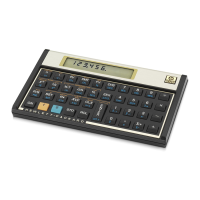Section 9: Branching and Looping 107
Y-registers (as also explained in Appendix A): that is, it will place the income
back into the X-register and place the test value into the Y-register. This is
necessary because when either the :2 instruction in line 005 or the :1
instruction in line 007 is executed, the number in the X-register is moved into the
Y-register; if the ~ instruction were not included, the test value 20,000, rather
than the income, would be in the Y-register when the b instruction in line 008
is executed.
Now, we'll store the required numbers in registers R
0
, R
1
, and R
2
, then we’ll run
the program, using Ê so that we can check that the branching occurs properly.
It’s good practice with programs containing conditional test instructions to check
that the program branches correctly for all possible conditions: in this case, if the
income is less than, equal to, or greater than the test value.
Keystrokes
(RPN mode)
Display
f] Sets RPN mode.
fs
007,43,33,002
Sets calculator to Program mode.
(Display shows program line at
which execution was halted at end
of preceding example.)
fCLEARÎ
000,
Clears program memory.
:0
001, 45 0
Recalls test value into X register
and places income in Y-register.
~
002, 34
Places income in X register and
test value in Y-register.
go
003, 43 34
Tests whether number in
X-register (income) is less than or
equal to number in Y-register
(20,000).
gi007
004,43,33,007
If condition is true, branches to
program line 007.
:2
005, 45 2
If condition is false, recalls 25%
tax rate to X-register.
gi008
006,43,33,008
Branches to program line 008.
:1
007, 45 1
Recalls 20% tax rate to X-register.
b
008, 25
Calculates tax.
fs
–12.36
Sets calculator to Run mode.
(Display shows results of running
of previous program.)

